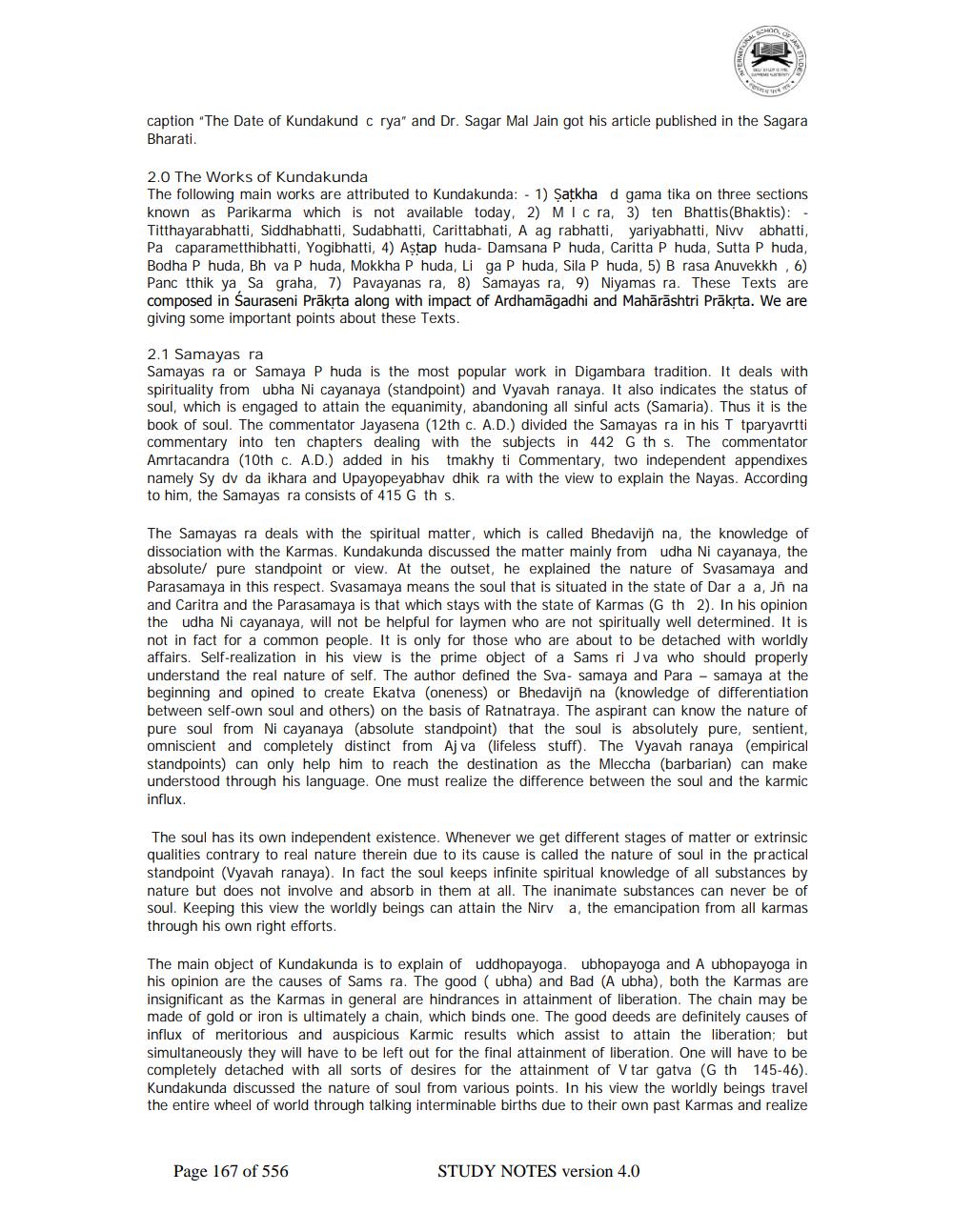________________
caption "The Date of Kundakund c rya" and Dr. Sagar Mal Jain got his article published in the Sagara Bharati.
2.0 The Works of Kundakunda The following main works are attributed to Kundakunda:- 1) Satkha d gama tika on three sections known as Parikarma which is not available today, 2) Mic ra, 3) ten Bhattis(Bhaktis): - Titthayarabhatti, Siddhabhatti, Sudabhatti, Carittabhati, A ag rabhatti, yariyabhatti, Nivyabhatti, Pa caparametthibhatti, Yogibhatti, 4) Astap huda- Damsana P huda, Caritta P huda, Sutta P huda, Bodha P huda, Bh va P huda, Mokkha P huda, Liga P huda, Sila P huda, 5) B rasa Anuvekkh, 6) Panc tthik ya Sa graha, 7) Pavayanas ra, 8) Samayas ra, 9) Niyamas ra. These Texts are composed in Sauraseni Prākta along with impact of Ardhamāgadhi and Mahārāshtri Prākta. We are giving some important points about these Texts.
2.1 Samayas ra Samayas ra or Samaya P huda is the most popular work in Digambara tradition. It deals with spirituality from ubha Ni cayanaya (standpoint) and Vyavah ranaya. It also indicates the status of soul, which is engaged to attain the equanimity, abandoning all sinful acts (Samaria). Thus it is the book of soul. The commentator Jayasena (12th c. A.D.) divided the Samayas ra in his T tparyavrtti commentary into ten chapters dealing with the subjects in 442 G ths. The commentator Amrtacandra (10th c. A.D.) added in his tmakhy ti Commentary, two independent appendixes namely Sy dv da ikhara and Upayopeyabhav dhik ra with the view to explain the Nayas. According to him, the Samayas ra consists of 415 G th s.
The Samayas ra deals with the spiritual matter, which is called Bhedavijň na, the knowledge of dissociation with the Karmas. Kundakunda discussed the matter mainly from udha Ni cayanaya, the absolute/ pure standpoint of view. At the outset, he explained the nature of Svasamaya and Parasamaya in this respect. Svasamaya means the soul that is situated in the state of Dar a a, Jn na and Caritra and the Parasamaya is that which stays with the state of Karmas (G th 2). In his opinion the udha Ni cayanaya, will not be helpful for laymen who are not spiritually well determined. It is not in fact for a common people. It is only for those who are about to be detached with worldly affairs. Self-realization in his view is the prime object of a Sams ri Jva who should properly understand the real nature of self. The author defined the Sva- samaya and Para - samaya at the beginning and opined to create Ekatva (oneness) or Bhedavijñ na (knowledge of differentiation between self-own soul and others) on the basis of Ratnatraya. The aspirant can know the nature of pure soul from Ni cayanaya (absolute standpoint) that the soul is absolutely pure, sentient, omniscient and completely distinct from Aj va (lifeless stuff). The Vyavah ranaya (empirical standpoints) can only help him to reach the destination as the Mleccha (barbarian) can make understood through his language. One must realize the difference between the soul and the karmic influx.
The soul has its own independent existence. Whenever we get different stages of matter or extrinsic qualities contrary to real nature therein due to its cause is called the nature of soul in the practical standpoint (Vyavah ranaya). In fact the soul keeps infinite spiritual knowledge of all substances by nature but does not involve and absorb in them at all. The inanimate substances can never be of soul. Keeping this view the worldly beings can attain the Nirva, the emancipation from all karmas through his own right efforts
The main object of Kundakunda is to explain of uddhopayoga. ubhopayoga and A ubhopayoga in his opinion are the causes of Sams ra. The good (ubha) and Bad (A ubha), both the Karmas are insignificant as the karmas in general are hindrances in attainment of liberation. The chain may be made of gold or iron is ultimately a chain, which binds one. The good deeds are definitely causes of influx of meritorious and auspicious Karmic results which assist to attain the liberation; but simultaneously they will have to be left out for the final attainment of liberation. One will have to be completely detached with all sorts of desires for the attainment of V tar gatva (G th 145-46). Kundakunda discussed the nature of soul from various points. In his view the worldly beings travel the entire wheel of world through talking interminable births due to their own past Karmas and realize
Page 167 of 556
STUDY NOTES version 4.0




